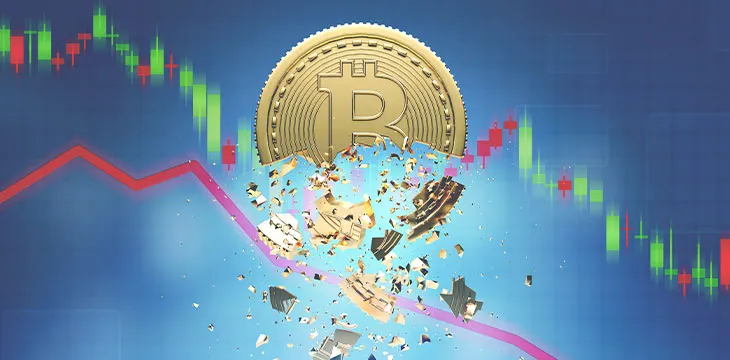|
Getting your Trinity Audio player ready...
|
This week saw another “stablecoin” asset decouple from its pegged asset after rapid selloffs on digital asset exchanges. The prices of inter-linked LUNA and UST tokens on the popular Terra network tanked, leading exchanges including Binance to suspend transactions in those assets.
The incident, one of several in recent years that has seen a stablecoin suddenly drop in value, has once again shaken confidence that monetary value can be safe on blockchain-based networks. The market is struggling to find a stablecoin it can trust as a buffer against other digital asset volatility, while exchanges once again switched off services as trouble loomed—protecting themselves, but not users.
Binance later resumed services as the situation calmed down. However, governance body the Luna Foundation Guard (LFG) reportedly sold off 85% of its U.S. dollar reserves, liquidated its US$1.5 billion in BTC reserves and other assets, and bought back about $850 million in BTC in an attempt to prop up UST’s price.
What are LUNA and UST?
UST is a U.S. dollar-linked stablecoin with a value based on demand algorithms, rather than collateral reserves of actual USD. The UST price fell from ~US$1 to about 30 cents early today, while LUNA (a non-stablecoin that drives the Terra network) lost most of its own value and was trading around the $1.54 mark after being as high as $116 dollars on April 5th. It was the second time UST had decoupled from the U.S. dollar in a few days.
Terra describes itself as “a suite of algorithmic decentralized stablecoins which underpin a thriving ecosystem that brings DeFi to the masses.” Built on the Cosmos SDK and Tendermint Consensus, it enables fast interactions between multiple “algo stablecoins” that match the value of different national fiat currencies. It’s designed to be easy to create and transact with new stablecoins. Its user community is known as “LUNAtics.”
1/ Liquidity brawl behind the scenes amid material $UST peg deviation on third-party venues.
Fighting back. More updates are incoming #LUNAtics. Hang on, fam.
Here are some resources to combat misinformation:
— Terra 🌍 Powered by LUNA 🌕 (@terra_money) May 9, 2022
“You can hold on to as much value and as many currencies as you want, without anyone telling you what you can do or how much you can withdraw. It’s really that simple,” its explanatory video proclaims.
The system is based on the native LUNA token, which holders stake on the proof of stake (PoS) network. Its operators also say the network has earned processors more value in transaction fees than any other blockchain, apart from BTC and Ethereum (it would be tough for anyone to knock either of those fee behemoths from their perches).
The following Twitter thread describes what happened and what could have happened. To summarize: the value of UST is based on demand for LUNA—which in turn is based on demand for DeFi services built on the Terra network and the number of users it has worldwide.
1/12 $UST is below $1 and lots of people are panicking, but let's relook at the fundamentals.
What is the relationship between $LUNA and $UST and three reasons why $UST will NOT depeg.
A short thread for a short crisis.🧵👇🏻$LUNA $UST $ASTRO @terra_money #Terra #Lunatics pic.twitter.com/K6EVOZQc7T
— 🧩MeetWawa 🐶 (@MeetWawa) May 8, 2022
What did this have to do with Binance?
The tweet below is a good summary of Binance’s many roles in Terra/Luna’s situation, as well as a description of how this is problematic:
In the Terra/Luna bailout, #binance is playing at least six roles
Investor in Terra
Largest Terra trading exchange
Arbiter of when Terra/Luna can trade
Member of Terra (LFG) governing council
Lender to market makers trading Terra
Recipient of bitcoin reserves backing Terra https://t.co/vIRNAiRt9O— New Money Review (@newmoneyreview) May 10, 2022
The lack of regulation and oversight that allows exchanges to play these roles is the same one that permits the trading free-for-all and wild profits that drive today’s digital asset market. There’s little evidence to suggest the blockchain industry creates any real economic value, or would even still exist, if not for speculative trading.
The complexity of “DeFi” network structures, which currently include stables of different assets all trading on the open market, serve both as multiple points of failure and convenient excuses for everyone to shrug off complaints as “technical issues” when users get burned. Exchanges hide behind the same glitches, disabling and enabling transactions on their platforms.
Users, for their part, are mainly price speculators gambling in the world’s unregulated digital currency casinos. They rightly cry foul when their positions disintegrate, yet exist on these platforms in the hope of making exponential gains and getting rich quickly. As with (even regulated) casinos, the biggest winners are the owners and operators—and all that money has to come somewhere.
Not-so-stable stablecoins
Blockchain developer Emin Gün Sirer pointed out that stablecoins of all types and generations have suffered issues with their values decoupling from the fiats they represent. He added that the best solution would be just one stablecoin to rule them all, and not pegged to any country’s national currency.
Even fully-collateralized fiat stablecoins have depegged. Even some of the weak algo stablecoins have recovered.
Some thoughts. 🧵👇
— Emin Gün Sirer🔺 (@el33th4xor) May 10, 2022
He also concluded he was “bullish on UST once the dust settles down.” While it may be the case (in theory) that stablecoins can experience price volatility and even potentially fail, that potential also puts them in a similar risk category to other digital assets. The whole point of a “stablecoin” is to reduce the risk of volatility altogether or even eliminate it. If users feel there’s any chance at all that a stablecoin might collapse, it won’t have long-term users.
Collateralized stablecoins like Tether (USDT) won trust with their claimed 100% backing with actual USD reserves. These reserves were later revealed to be far lower than 100%, leaving Tether’s value supported mostly by longevity in the market and network effect. Realizing that users would trust a stablecoin (at least temporarily) backed by less-tangible factors, developers began working on new generations of stablecoins, relying on trading algorithms and demand to support pegs.
It’s important to remember that national fiat currencies themselves are essentially algo-backed stablecoins, with their own values based on demand and issuers’ reputations. They have also proven less solid in recent times, with inflation creating headaches for the general populace in many countries.
Only one usable, secure and scalable blockchain network is capable of winning the public’s trust and solving volatility problems. Its value should come from its utility in the wider economy and usefulness to everyone. It must also have proven its trustworthiness over an extended period of time, and it should stand apart from the casino exchange industry. The original Bitcoin protocol is all these things—it’s a shame that its reputation is too often overshadowed by excesses and hype surrounding blockchain technology.
Watch: CoinGeek New York panel, Bitcoin & Blockchain – Can Real Value Come from Real Utility?
https://www.youtube.com/watch?v=IBAJr8vP5Bw

 09-12-2025
09-12-2025 





